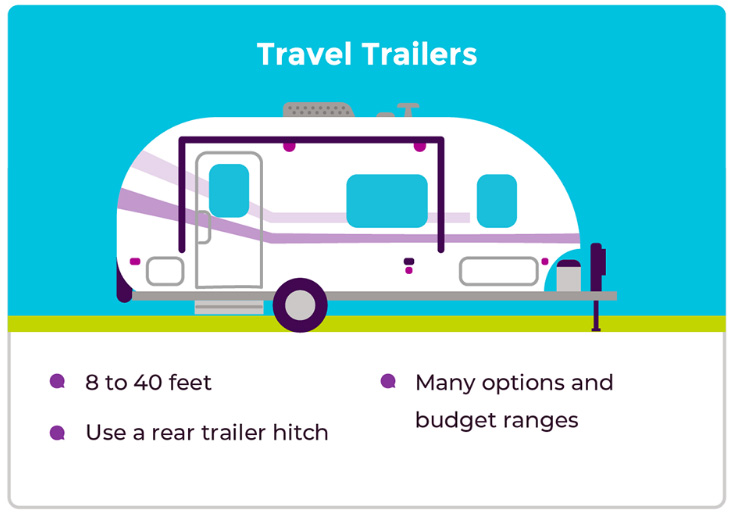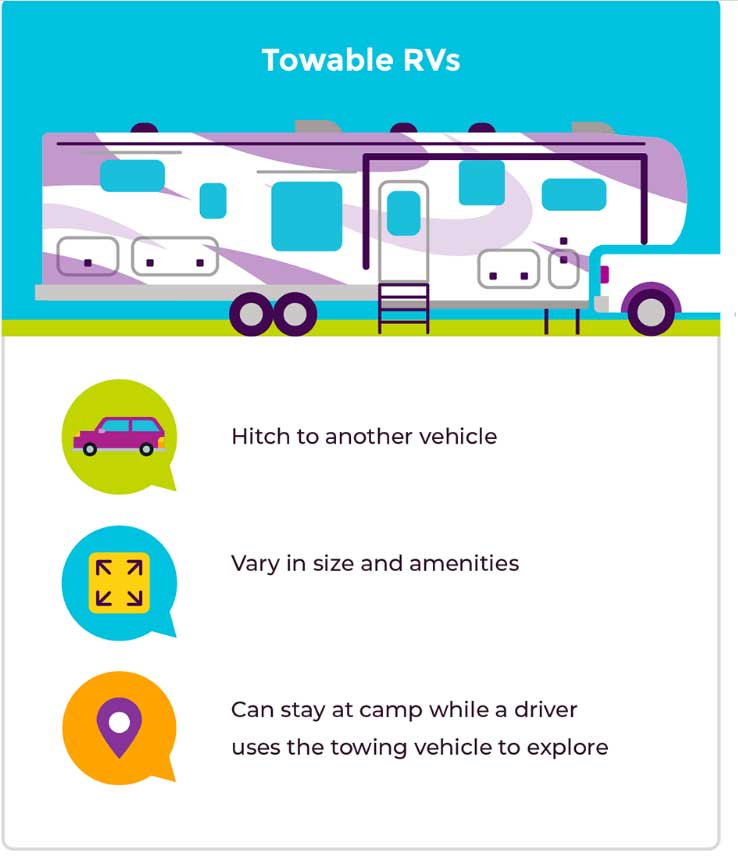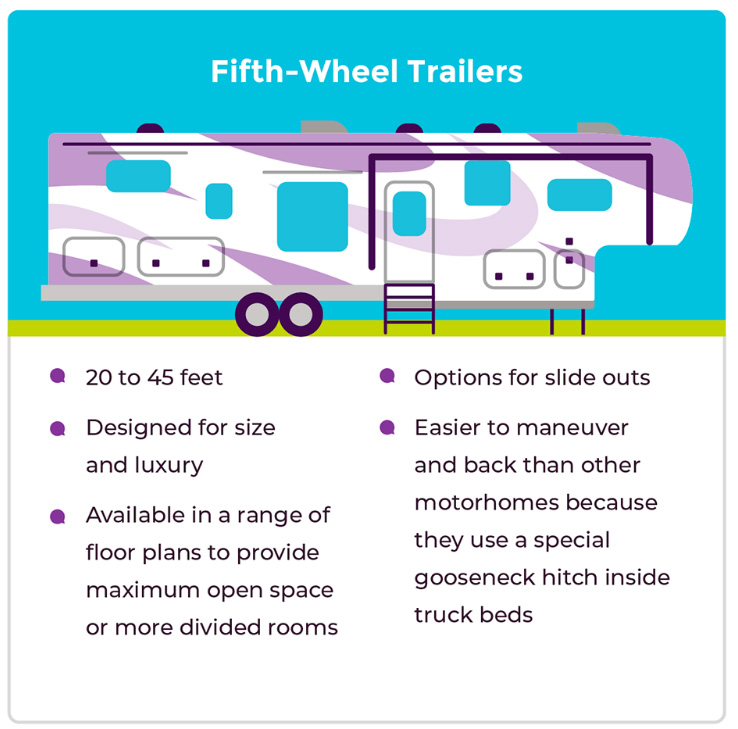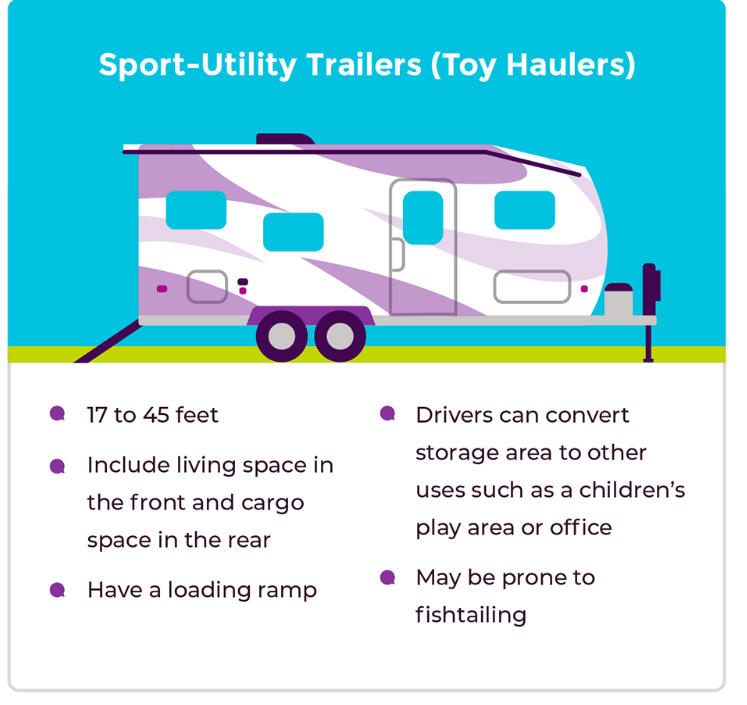Roughing it in a tent isn’t for everyone. As of 2017, more than 10 million American households were enjoying the great outdoors in RVs — and another 17 million households were on the hunt for the right camper for their adventures.
Whether the teeniest teardrop trailer or the largest Class A motorhome, the right RV is waiting for you. Here’s how to figure out which one is best for your family.
The Main Types of RVs
Manufacturers built the first RVs in 1910, and the industry has been growing ever since. With nearly 40,000 RV shipments in August 2020, RV demand is up 17.3 percent compared to August 2019. Market experts expect RV sales to grow 7 percent through 2024. With singles, families, and retirees interested in RVing and young adults excited about #vanlife, major RV makers such as Thor, Forest River, and Winnebago are innovating to design and configure the right RV for any traveler. Your first RV decision comes down to two options: motorized or towable.
Motorized RVs
A motorized RV has an engine and you drive it instead of towing it. (Some motorized RVs can even tow a vehicle.) You don’t need to hook up, haul, and back a trailer; you just need to load up your belongings and drive. When you arrive at your destination, all you need to do is park, level the vehicle, and expand any slide outs.
Inside, motorized RVs often have bedrooms, kitchens, living rooms, and toilets along with amenities such as TVs, refrigerators, and heating and cooling systems. Setups can range from minimalist to all the comforts of home.
The world of motorized RVs includes four main sub-categories:
- Class A
- Class B
- Class C
- Campervan
Towable RVs
If you have a vehicle that can haul a camper, consider a towable RV. The vehicle you use for towing will determine how big a towable you can haul. From small teardrop trailers to long toy haulers, towable RVs range from eight to 40 feet. If you’re short on storage space, some towables are compact for easy parking when you’re not on the road.
Since they don’t have engines, towable RVs tend to cost less to purchase and maintain than motorized RVs. Plus, your towable RV gives you flexibility: Once set up, the RV can stay at camp while you drive around to explore. However, you’ll need to get comfortable with hitching, towing, backing, and unhitching a trailer.
Towable RVs come in five main types:
1. Fifth wheels
2. Travel trailers
3. Sport-utility trailers
4. Truck campers
5. Pop-ups
Types of Motorized RVs
Here are some things to keep in mind for each main class of motorized RV.
Class A motorhomes
When you imagine someone cruising along in a motorhome, odds are you picture a rectangular Class A. While Class A RVs include the largest motorhomes available (up to 45 feet!), some Class A RVs are as short as 21 feet.
Class A RVs are often associated with luxury configurations too. If creature comforts are crucial to your travels, a Class A just may be a first-class choice. They’re typically built on a commercial truck or bus chassis and flaunt these features.
- Large spaces for room, living areas, and storage
- Expansive options for amenity, floor plans, slide outs, and more
- Gas or diesel options
However, they also come with a few downsides.
- They cost the most for fuel, insurance, repairs, and purchase.
- Drivers may require special driver licenses depending on the size of the RV.
- They’re large and harder to maneuver than smaller RVs.
One more thing to keep in mind: Because these vehicles aren’t easy to maneuver, you may want to tow a separate vehicle to drive around when your RV is set up at camp.
Class B motorhomes
Often referred to as conversion vans, Class B motorhomes are typically 23 to 33 feet. Some drivers find these vehicles easier to maneuver than Class A motorhomes, especially when navigating narrower, twister roads or heading to remote locations for boondocking (off-the-grid camping).
Class B motorhomes are built on a van chassis, and they usually have these common features.
- Their cost is similar to Class A motorhomes, but they’re cheaper to fuel and maintain.
- They typically provide enough space for only one or two people, but some are configured for up to four.
- Some have onboard bathroom facilities such as a toilet and shower.
- They commonly include dropped floors or raisable roofs for standing comfort and additional sleeping space.
- Generally, all living areas share one space.
Class C motorhomes
Does the RV passing have a cabin area above the driving cab? That’s a Class C motorhome. Its over-cab compartment often contains a sleeping area, or it may be set up for storage or an entertainment system.
Class C motorhomes are built on a truck chassis (including many “Class B+” RVs) and are typically 21 to 41 feet. They boast these features.
- Gas mileage is normally better than Class A motorhomes, but not as good as Class B motorhomes.
- Options for storage are usually available.
- Amenities are similar to Class A motorhomes although the size is smaller.
- They’re similar in parking and maneuverability to Class B motorhomes.
- Larger models can tow a vehicle.
- Living and sleeping spaces tend to be comfortable.
Class C motorhomes are a family favorite. They’re cheaper to purchase and maintain than Class A motorhomes, but roomier than Class B motorhomes. Larger models may have more separation of living spaces too. Overall, Class C RVs can be one of the most versatile types of RV.
Campervans
From classic Volkswagen Westfalias and Vanagons to sleek modern styles, campervans can be considered Class B RVs with some crucial differences. Class B RVs tend to look more like RVs, while campervans stick closer to their van roots.
Campervans are generally more compact, making them perfect for solo or duo travelers, or small families with young children or who are fine sharing close quarters.
Typically, campervans have one or two built-in sleeping areas, storage compartments, and a small kitchenette. Usually, they don’t include built-in toilet areas, and you may have to add other amenities such as running water.
Types of Towable RVs

Towable RVs give you even more options for camping adventures.
Fifth-wheel trailers
Ranging from 20 to 45 feet long, fifth wheels are the Class A motorhomes of towable RVs. Designed first and foremost for size and luxury, fifth wheels are available in a range of floor plans to provide maximum open space or more divided rooms. Options for slide outs can provide even more space.
Despite their size, fifth wheels can be easier to back up than other towables. Instead of hitching at the rear of the vehicle, fifth wheels use a special gooseneck hitch inside your truck bed. However, fifth wheels usually weigh more than 10,000 pounds, so check that your truck has the right hauling capacity. And yes, if you want a fifth wheel, you need a pickup truck.
Travel trailers
Often when people think of travel trailers, they think of the classic rounded lines and gleaming metal of an Airstream. However, travel trailers can be small (such as 8-foot teardrops) or large, reaching around 40 feet. Unlike a fifth wheel, you can use a rear trailer hitch to tow even the longest travel trailers.
Towable travel trailers have some of the most diversity in terms of amenities, costs, layouts, storage, slide outs, and other options.
Depending on size, travel trailers can be trickier to maneuver and back up than fifth wheels, and you’ll need to be careful in situations with tight access, such as overpasses, winding roads, or small parking lots.
Sport-utility trailers (toy haulers)
Sport-utility trailers do double duty. In addition to including living space up front, these trailers boast a rear lockable, weatherproof storage area to hold an ATV, motorcycle, or other outdoor gear. And they come with a built-in loading ramp.
If desired, you can convert the storage area for other uses such as a children’s play area, mobile office, fly fishing workshop, or a covered back porch.
Keep two things in mind: You’ll have a smaller living space, and toy haulers may be more prone to fishtailing while you drive.
Truck campers
Got a pickup and want to keep your camping simple and compact?
Secure a truck camper to your pickup bed, and you’ll be ready to go in no time. Plus, your trailer hitch remains free for other hauling. Usually six to 12 feet long, smaller truck campers can be used with some smaller pickups. Most often, you’ll want at least a half-ton, heavy-duty truck.
Truck bed campers sit inside the truck bed. Once you arrive at your destination, all you need to do is park the truck and make sure it’s level. While living space tends to be more compact, some models boast pull-out extensions, slide outs, kitchens, over-cab spaces, and even bathrooms to increase room and comfort. However, truck campers can be tricky to secure and remove.
Pop-up campers
Typically eight to 20 feet long, towable pop-up campers are compact for storage but expand up and out for living space. The mesh and fabric sides don’t offer the same security as hard-sided campers, but they let you feel like you’re in a tent while having the comfort of sleeping on a mattress.
Pop-ups require a little more setup and takedown time, but once you understand the process, it can take less than an hour.
Onboard heaters and air conditioners can help keep you comfortable, but a pop-up is harder to temperature control than other styles. However, pop-ups can be the most budget-friendly camper. Plus, because they’re lighter weight, you can tow them with a wider range of vehicles.
How to Choose the Best Camper for Your Adventures
There’s no one right camper—there’s only a right camper for you. Here are questions to consider when deciding which camper should be your camping companion in the great outdoors.
- Understand the level of simplicity or luxury you prefer, and list out what amenities you consider vital, optional, or non-essential.
- Know your budget. Do you want to purchase outright or finance the purchase and pay it down over time? If you want the finest models, opt for a Class A motorhome or fifth wheel. If you’re in the market for a spare or budget RV, look at campervans, truck campers, or pop-up trailers. If you want something in the middle, consider a Class B or C motorhome, or a travel or sport-utility trailer.
- New or used? New RVs are the most costly, while used RVs require extra diligence to make sure the camper is in good shape. If you’re in the market for a used RV, check websites such as RV Trader, RVt, and Classy RV as well as Facebook groups and Craigslist.
- Where do you want to camp? National parks? Commercial campgrounds? Wilder areas? How often do you want to camp, and for how long? If you don’t camp much or you generally camp in campgrounds with restrooms, you may want to opt for a campervan, truck camper, or pop-up trailer without a restroom. However, if you plan to camp often or boondock off-the-grid, you may want an RV with more amenities that’s not too hard to maneuver, such as a Class B motorhome or travel trailer.
- Think through how many people (and pets) will be in the camper. A large family may be more comfortable in a Class A motorhome, fifth wheel, or large travel trailer. If you’re flying solo, a campervan, teardrop trailer, or truck camper may suit you better.
- Do you want to tow with your current vehicle? If you own a large truck with a hitch, you’re set to tow most RVs. But if you don’t, check the hauling limits of your vehicle. You may need to stick with a lighter weight truck camper, teardrop travel trailer, or pop-up trailer.
- How much gear do you need to store? If you want to haul large sporting equipment, a sport-utility trailer (toy hauler) may be your best bet.
- Are you comfortable driving and backing up a trailer or long vehicle? If not, are you willing to learn? If driving or hauling a large RV isn’t your thing, stick with a campervan or truck camper.
Go Find Your Best Camper
Everyone’s camping style is different. With the range of options and camper styles available today, though, the right camper is waiting for you. Go find it, and hit the road! East Coast Campers and More in Frankford, Delaware specializes in towable RV’s and can provide you with sales, parts, and service. We can help you find the best camper for your needs.





Recent Comments